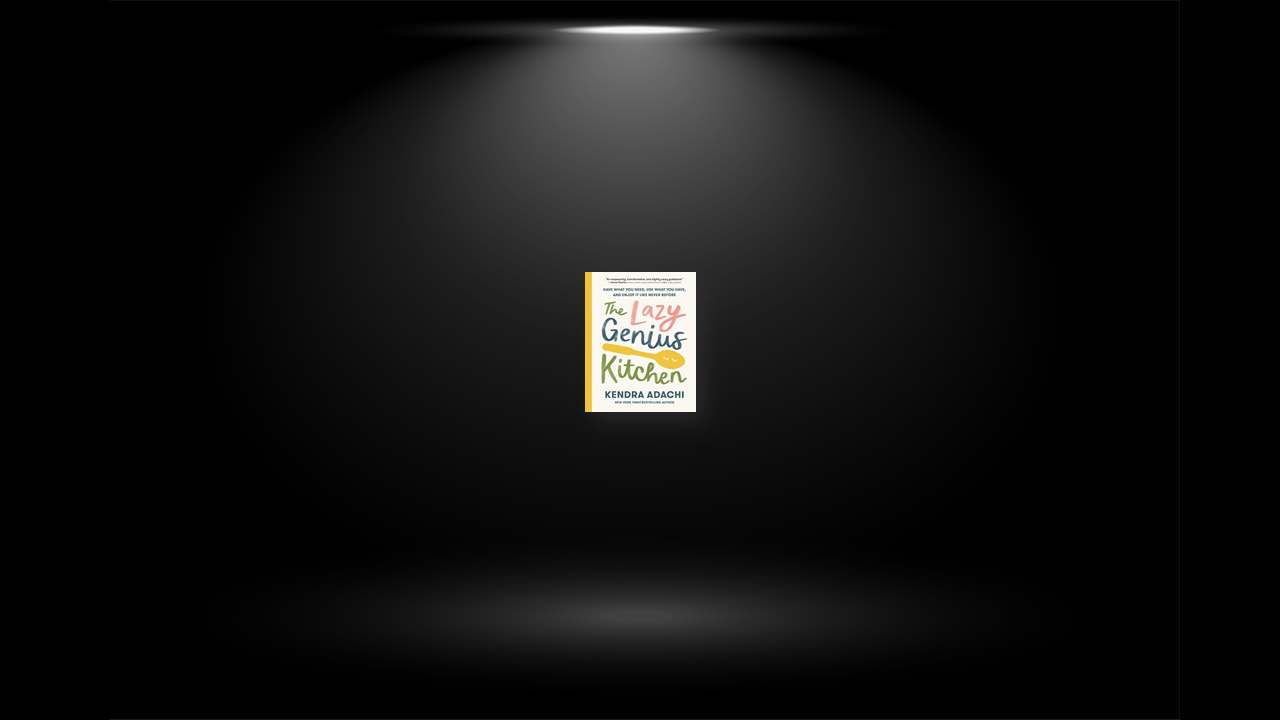Step 1—Prioritize: Name What Matters Most
What Could Matter
As an example, let’s think about what could matter when you shop for food: price, quality, convenience, selection, experience, sustainability, and if a place has grocery pickup or shopping carts shaped like racecars for your toddler. Those could all be important, right?
However, there is no grocery store on earth that can prioritize all those things. None. Whole Foods prioritizes quality and sustainability over price. Aldi prioritizes price over selection and experience. Trader Joe’s prioritizes its personal identity over carrying multiple brands. Every store has to prioritize something, or it won’t survive.
The same is true for you. You have to prioritize. If you try to tend to everything, you’ll tend to nothing—at least not well. You have to drill down to what matters most to you, and the first step is listing all the possibilities.
What Does Matter
Once you have your list of what could matter, you just start crossing stuff off. Now, for some people, that will prove a touch more difficult than for others. Choosing is just the worst. If you need some help narrowing down, here are two thoughts that could ease the process.
First, live in the season. Your life in the kitchen is massively impacted by how much time, emotional margin, money, and many children you have. And those things change with each season of life. As you narrow down the list of what could matter to what does matter, think about what matters right now. No ideals, no futures, no “when this changes.” Right. Now. When you live in your season, you know life will eventually be different while still embracing where you are now.
Second, what makes you crazy? Identifying pain points is where the magic happens. If you can name what makes you frustrated about cooking, your space, and even certain tools, you can more easily name what matters and therefore have a much better experience. No more yelling at inanimate objects.
What Matters Most
Now comes the hard part. You have to narrow your list of three down to one. You’re not dismissing what does matter outright. Your top three priorities will all play a role in how you experience your kitchen, but you need a main thing. Why? You want an engine that pulls the train. You want a sun that holds everything in orbit. You want a killer pair of jeans that are the foundation for all your amazing outfits.
Step 2—Essentialize: Get Rid of What’s in the Way
Now that you’ve named what matters most, you know what doesn’t matter anymore. It’s time to see your space with new eyes and get rid of what’s in the way. Thankfully, essentializing like a Lazy Genius is inherently simple. It’s only about removal. Nothing else.
So often, we organize first, but you can’t organize until you essentialize. Otherwise, you’re finding a home for things that don’t need to be there. How many times have you bought some kind of storage solution for a thing you don’t even use?
You must get rid of what’s in the way before you put everything in its place. When you fill your life with things that are not essential to what matters to you, you unintentionally add noise to your life. That can be the visual noise of cookbooks you don’t open or the mental noise of unrealistic expectations. And managing noise, especially in the kitchen, is part of why you’re always tired.
The irony is that our typical reaction to the noise is to add more to it. You might think, for example, that your frustration is because your pots and pans are cheap and don’t work well. While that might be true, if you buy a new set of pots without getting rid of the old ones, now you have double pots.
And what if the truer problem isn’t the pots but, rather, that you were never taught a few basic cooking skills? New pots won’t help that, but you buy them anyway, create more noise, and stay frustrated.
Adding to the noise is never the answer. Essentializing is. Name what matters, and then get rid of what’s in its way.
Step 3—Organize: Put Everything in Its Place
You’ve named what matters. You’ve gotten rid of what’s in the way. Next up? You look at what’s left and put it in its place. Now you organize. Organization is simply putting what matters in its place.
That’s it. It can be pretty or ugly, functional or haphazard, rational or completely bizarre. All that matters is that you’re serving what matters to you. You can organize anything—thoughts, decisions, plans—but when you organize your stuff, you get an automatic failsafe.
Your space is finite. You cannot pull a Molly Weasley and magically make your house bigger. The world of Harry Potter can teach us many things, but space expansion probably shouldn’t be one of them. Because your home—the pantry, your cabinets, that hall closet that holds the extra cereal—is finite, you do not have to choose your limits. They’re already there in the form of shelves and drywall.
Embrace the limits of your space. Reframe how you feel about them. The chances are good that you want a pretty kitchen. You want to open cabinets and be met with order. You want your counters, your recipe storage, your pantry, your table, the containers inside your fridge to be aesthetically pleasing
However, the tendency is to make something pretty before making it work. You think you won’t mind the effort of getting a stepstool to reach the pretty bowl on the pretty open shelving that’s just out of your reach every time you want cereal, but when you’re tired and cranky and the rest of the kitchen is a wreck, you will mind.
Aesthetics could absolutely be your top priority, but please make sure a space is functional, too, especially before you spend the effort and cash on something that might not matter as much as you think it does
Step 4—Personalize: Feel Like Yourself
The Seven P’s of Personalizing
Personality
This is the most obvious one, right? You feel like yourself when you embrace your personality and act the way you most naturally want to. For example, you might be a naturally reserved, observant, introverted person. You’re not the one who carries a group conversation, but you’re definitely invested in it when it happens. Still, you love quiet and not having to talk. That aspect of your personality probably feels natural when you’re preparing dinner alone, but not so much when you have people over for a birthday dinner.
People
Who are your people? Who lives with you in your house? Who doesn’t live with you but still feels at home? People play a huge role in personalizing your experience in the kitchen, not only in how you act but in how you consider what they need, too.
Priorities
You’ve already learned this part: name what matters. When you know your priorities, you can personalize how you do anything in the kitchen with greater intention. If what matters most to you about cleaning the kitchen is to do it together as a family, then of course you want to do it as a family. But what if an aspect of your personality is to do things quickly? Sadly, children and efficiency are not always great partners.
Proficiency
You could struggle feeling like yourself in the kitchen because you’re trying to turn out meals like Martha Stewart, even though you’re still not sure how to make a solid grilled cheese. Being proficient at cooking, planning, prepping, and all those kitchen things does not always come naturally. It must be learned, which means someone must teach you. It often takes practice…lots of practice. But it starts with being shown how.
Process
You should feel like yourself during the process of planning, prepping, and all the rest. If your preferred process is slow and steady, be slow and steady. If you prefer to cook everything in bulk because you love the process of batching, cook everything in bulk! Respect your process. Embrace what makes you feel like yourself as you hang out in your kitchen.
Pleasure
What do you like? What makes you happy? What feels fun? What helps you take a deep breath and settle into yourself as you live life in your kitchen? your pleasure could be open windows while you cook, music while you have a meal, a favorite pen while you make your shopping list, a mountain of fresh produce from the farmers’ market after you shop, a beautiful cookbook to flip through as you plan…the possibilities are endless and personal. And that’s the gift, isn’t it? It’s personal. It’s okay if what brings you pleasure in the kitchen is super different from your best friend, your mom, or even Oprah. You get to decide what you love.
Peace
If your enjoyment in the kitchen was mathematically analyzed, I think peace would claim a decent percentage. The kitchen can feel annoying for a lot of reasons, one of which is being super stressed by All the Things. Depending on your season of life, peace might not be there at all. But when it’s there? Game-changer. So, what brings you peace? Personalize your Lazy Genius kitchen by naming what brings you peace.
Step 5—Systemize: Stay in the Flow
Systems themselves aren’t bad. In fact, some of us thrive on systems, on routines that keep us from turning into The Hulk. Or maybe you see the value in systems keeping you from turning into The Hulk so much. But here’s the problem. Too often, you let the system blindly lead instead of listening to your soul. You ignore rhythms in exchange for rules.
Think of your systems less like a machine and more like a boat on a river. Remember, the point is to stay in the flow. Sometimes you go fast, sometimes slow, sometimes you get turned around or hit rapids that are trying to murder you, sometimes you take a break to rest on the shore, and when it’s time to keep going, the water is still moving and waiting for you to ease back in.
Because that’s what life does, right? It keeps moving whether you want it to or not. That is especially true of life in your kitchen. If you don’t pay attention to the flow, life will still keep moving, the water will get rougher, and you’ll feel like you’re holding on for dear life at every turn.
So, instead of letting the river get all jammed up or turn into a waterfall or whatever happens to rivers, use a Lazy Genius principle or two to stay in the flow. A few simple choices will make the trip more pleasant, even when those rapids come.


